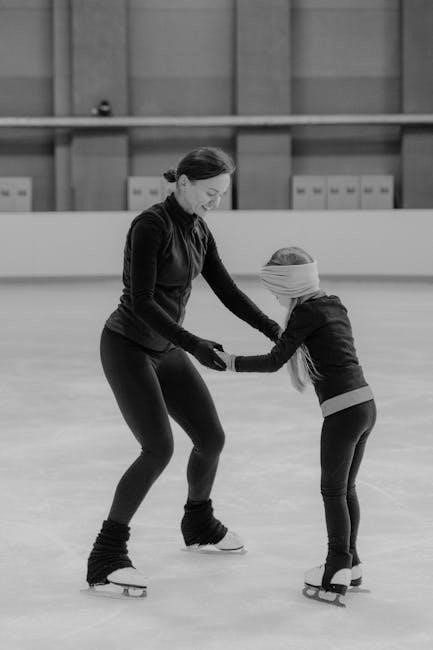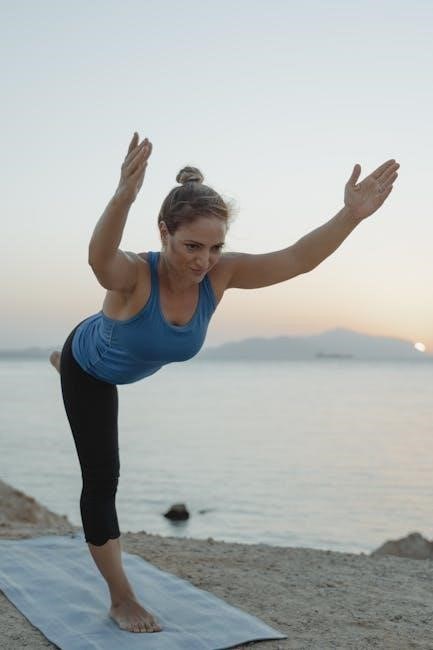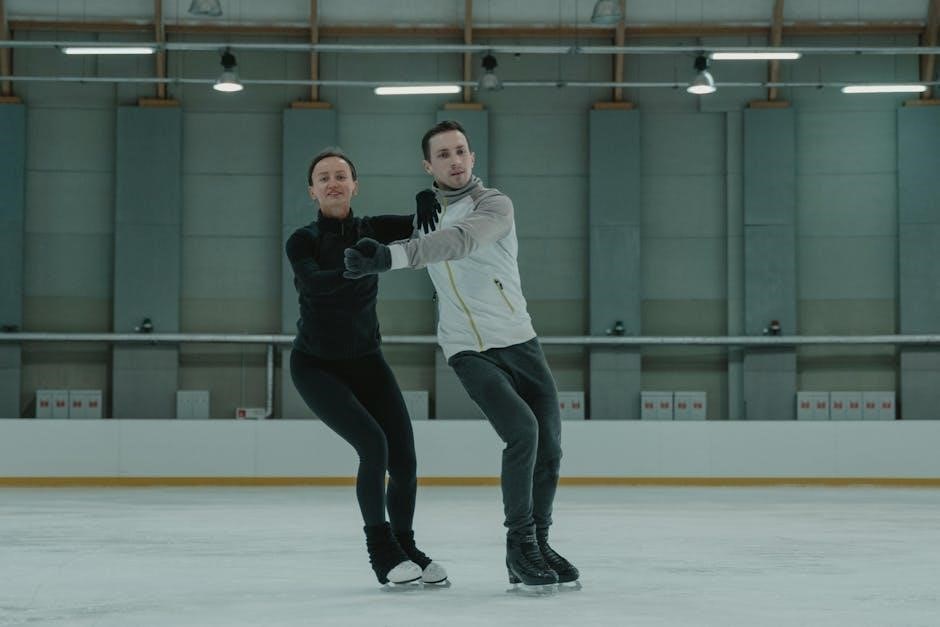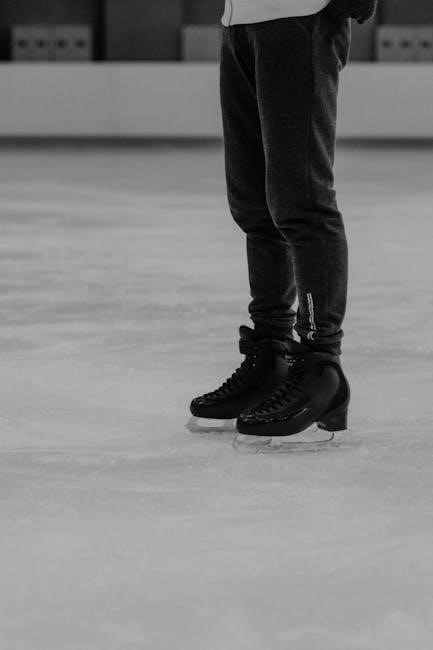Scapular dyskinesis is a movement dysfunction of the shoulder blades, often linked to shoulder injuries․ Targeted exercises aim to restore proper scapular function and prevent further complications․
1․1 Understanding Scapular Dyskinesis
Scapular dyskinesis refers to an abnormal movement pattern of the scapula during shoulder activities, often linked to shoulder injuries or discomfort․ It occurs when the scapula fails to move in sync with the humerus, disrupting normal shoulder function․ This condition is commonly associated with subacromial impingement, rotator cuff tears, and shoulder instability․ The altered scapular position or movement can lead to pain, reduced range of motion, and decreased strength․ Early identification and targeted exercises are crucial to restore proper scapular mechanics and prevent further complications․ Exercises such as the scapular clock, towel sliding, and serratus anterior punches are often recommended to strengthen the shoulder girdle muscles and improve stabilization․ Addressing scapular dyskinesis through structured rehabilitation can significantly enhance shoulder function and overall mobility․

Assessment and Diagnosis
Clinical evaluation and physical assessment techniques are essential to identify scapular dyskinesis․ These include strength tests, range of motion assessments, and observation of scapular movement patterns․
2․1 Clinical Evaluation
Clinical evaluation for scapular dyskinesis involves a comprehensive assessment to identify abnormalities in scapular movement and shoulder function․ This process begins with a detailed patient history to understand symptoms, such as pain or limited mobility․ Physical examination includes visual inspection of the scapula at rest and during movement, noting any signs of winging or altered positioning․ Strength testing of the shoulder muscles, particularly the rotator cuff and scapular stabilizers, is conducted to detect imbalances․ Range of motion assessments help determine if there are restrictions in shoulder mobility․ Specialized tests, such as the Scapular Assistance Test (SAT) and Scapular Reposition Test (SRT), are often used to evaluate the scapula’s role in shoulder function․ These tests help differentiate between scapular-related issues and other shoulder pathologies․ Clinicians may also observe how the scapula moves during active movements like arm elevation, looking for signs of dyskinesis․ Additionally, palpation may be used to assess muscle tone and tenderness around the scapular region․ The findings from these evaluations guide the development of targeted rehabilitation programs, focusing on strengthening, stabilizing, and improving the coordination of the scapular muscles․ Early identification of scapular dyskinesis is crucial to prevent progression and promote effective recovery․
2․2 Physical Assessment Techniques
Physical assessment techniques for scapular dyskinesis involve a systematic evaluation of scapular movement and muscle function․ The Scapular Scratch Test is commonly used to assess the scapula’s ability to retract and protract․ The Wall Slide Test evaluates dynamic scapular movement during arm elevation, helping to identify dyskinesis patterns․ Palpation of the scapular muscles, such as the trapezius and rhomboids, can reveal muscle imbalances or excessive tension․ Observation of scapular winging during active movements, like arm raising, is another key assessment․ These techniques help clinicians determine the severity of scapular dysfunction and guide the selection of appropriate exercises․ The goal is to restore normal scapular mechanics and improve shoulder stability․ Regular physical assessments ensure progress tracking and adjustment of rehabilitation programs as needed․

Exercise Rehabilitation
Exercise rehabilitation for scapular dyskinesis focuses on a progressive program to strengthen scapular muscles and improve movement patterns․ It includes early, intermediate, and advanced strengthening phases to restore function․
Phase I of scapular dyskinesis rehabilitation focuses on early strengthening to stabilize and activate the scapular muscles․ Gentle exercises like shoulder blade squeezes, wall slides, and assisted scapular rotations are introduced․ These movements help improve scapular positioning and reduce pain․ Patients are encouraged to perform these exercises 2-3 times daily, with low repetitions to avoid fatigue․ Progression is gradual, ensuring proper form to prevent compensation․ This phase lays the foundation for more advanced strengthening in later stages, aiming to restore normal scapular mechanics and prepare the shoulder for increased activity․ Breathing techniques are also incorporated to enhance muscle activation and relaxation․ In Phase II, intermediate strengthening exercises are introduced to further enhance scapular stability and muscle endurance․ Exercises such as the Scapular Clock, Towel Sliding, and Theraband rows are commonly used․ These activities focus on improving the coordination and strength of the scapular stabilizers, including the serratus anterior and trapezius muscles․ Resistance is gradually increased, often using elastic bands or light weights, to challenge the muscles without overloading them․ Patients are encouraged to perform 3 sets of 12-15 repetitions for each exercise, ensuring proper form to avoid compensation․ This phase also incorporates dynamic movements to mimic functional activities, preparing the shoulder for more complex tasks․ Breathing techniques and proprioceptive exercises are emphasized to maintain optimal scapular positioning․ The goal is to build a stronger foundation for advanced exercises in Phase III while minimizing the risk of injury or setbacks․ Phase III focuses on advanced strengthening to restore full shoulder function and prepare for return to sport or heavy activities․ Exercises like high-level Theraband rows, plyometric wall slides, and dynamic stabilization drills are introduced․ These activities challenge the scapular muscles under greater loads and speeds, improving power and endurance․ Patients progress to unilateral exercises, such as single-arm punches and resisted rotations, to address any remaining imbalances․ Proprioceptive training on unstable surfaces, like balance boards, is also incorporated to enhance neuromuscular control․ The intensity and complexity of exercises are increased to simulate real-world movements, ensuring the scapula functions efficiently in all planes of motion․ The goal is to achieve optimal strength, stability, and coordination, enabling a seamless transition back to full activity without recurrence of dyskinesis․ Regular monitoring ensures proper progression and prevents overexertion․ Additional exercises include the scapular clock and towel sliding to improve scapular mobility and strength, complementing the rehabilitation phases and enhancing overall shoulder function effectively․ The scapular clock exercise is a dynamic movement designed to improve scapular mobility and synchronization․ Patients place their hands behind their back and imagine a clock face on their scapula․ They then move their arms in a way that mimics the clock hands, from 12 o’clock down to 6 o’clock and back․ This exercise targets the serratus anterior and trapezius muscles, enhancing scapular rotation and stabilization․ It is typically performed in sets of 10 repetitions, focusing on controlled, smooth movements to ensure proper engagement of the scapular stabilizers․ This exercise is often incorporated into Phase II or III of rehabilitation, helping to restore normal scapular mechanics and reduce the risk of recurrence․ The towel sliding exercise is a simple yet effective method to improve scapular stability and strength․ It involves placing a towel on a smooth surface, such as a table, and positioning the upper arms on it․ Patients are instructed to slide their arms forward and backward while maintaining contact with the towel, ensuring minimal shoulder movement․ This exercise targets the scapular stabilizers, particularly the serratus anterior and trapezius muscles, enhancing their ability to control scapular motion․ It is commonly used in the early stages of rehabilitation to restore proper movement patterns and reduce symptoms associated with scapular dyskinesis․ The exercise is typically performed in sets of 10-15 repetitions, focusing on controlled movements to maximize muscle engagement and promote recovery․ Stretching and foam rolling are essential for improving flexibility and reducing muscle tension around the scapula․ Gentle range of motion exercises and targeted stretches help alleviate tightness and promote recovery․ Gentle range of motion exercises are crucial for individuals with scapular dyskinesis․ These exercises focus on improving flexibility and reducing stiffness in the shoulder region․ Pendulum swings, arm circles, and wall slides are commonly recommended․ They help restore natural movement patterns without putting excessive strain on the muscles․ Additionally, these exercises can be modified to suit different stages of recovery, ensuring they remain effective and safe․ Regular practice not only enhances mobility but also supports the overall rehabilitation process, making it easier to progress to more intensive strengthening exercises later on․ Consistency is key to achieving long-term benefits and preventing future complications․ A well-structured home exercise program is essential for managing scapular dyskinesis; It includes exercises like shoulder blade squeezes and pendulum swings, ensuring consistency and proper guidance for recovery․3․1 Phase I: Early Strengthening
3․2 Phase II: Intermediate Strengthening

3․3 Phase III: Advanced Strengthening

Additional Exercises
4․1 Scapular Clock Exercise


4․2 Towel Sliding Exercise

Stretching and Foam Rolling
5․1 Gentle Range of Motion Exercises

Home Exercise Program

6․1 Structuring a Home Exercise Routine
Structuring a home exercise routine for scapular dyskinesis involves creating a balanced program that combines strengthening, stretching, and stabilization exercises․ Start with gentle range of motion exercises, such as pendulum swings, to improve mobility without strain․ Incorporate scapular stabilization exercises like shoulder blade squeezes and wall slides to enhance muscle control and prevent winging․ Gradually introduce resistance-based exercises using resistance bands or light weights to strengthen the rotator cuff and scapular muscles․ Include exercises like the scapular clock and towel sliding to improve scapular mechanics․ Ensure each exercise is performed with proper form, typically 3 sets of 10-15 repetitions, 2-3 times daily․ Maintain consistency and adjust the routine as progress is made, always consulting with a healthcare professional to ensure safety and effectiveness․
Prevention and Maintenance
Preventing scapular dyskinesis involves regular strengthening exercises, proper posture, and consistent scapular stabilization techniques․ Incorporate exercises like scapular clock and shoulder blade squeezes to maintain muscle balance and stability․
7․1 Strengthening and Stabilization Techniques
Strengthening and stabilization exercises are crucial for addressing scapular dyskinesis․ These techniques focus on improving the endurance and coordination of scapular muscles, such as the serratus anterior, trapezius, and rhomboids․ Key exercises include the scapular clock, PNF D2 pattern, and towel sliding․ These movements help restore proper scapular mechanics and enhance shoulder stability․ Additionally, incorporating unstable surface training and PUP exercises can further improve muscle activation and reduce the risk of recurrence․ Consistency in performing these exercises ensures long-term benefits, promoting better posture and functional movement patterns․ Regular practice also aids in preventing shoulder injuries and maintaining optimal scapular function during daily activities and sports․
